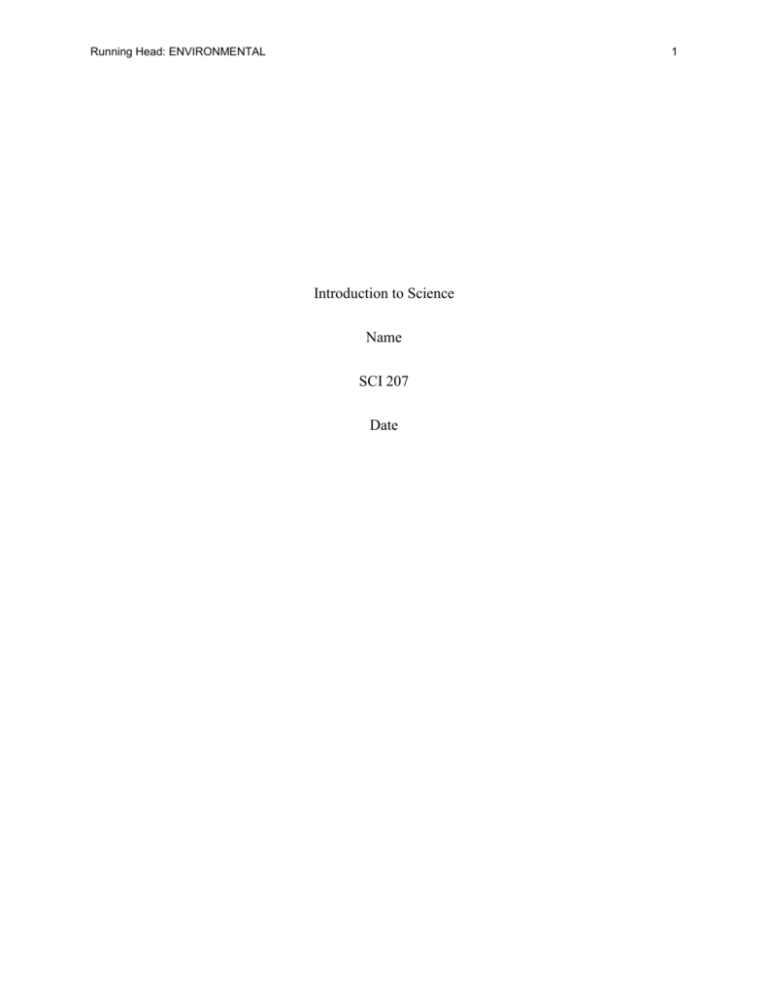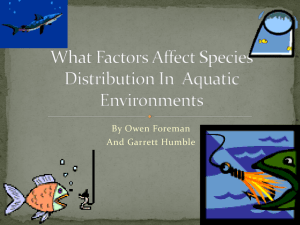INVIRONMENTAL 1 Introduction to Science Name SCI 207 Date
advertisement

Running Head: ENVIRONMENTAL 1 Introduction to Science Name SCI 207 Date INVIRONMENTAL 2 Lab 1 - Exercise 1: Data Interpretation Dissolved oxygen is oxygen that is trapped in a fluid, such as water. Since many living organism requires oxygen to survive, it is a necessary component of water systems such as streams, lakes and rivers in order to support aquatic life. The dissolved oxygen is measured in units of parts per million (ppm). Examine the data in Table 4 showing the amount of dissolved oxygen present and the number of fish observed in the body of water the sample was taken from; finally, answer the questions below. Questions 1. What patterns do you observe based on the information in Table 4? The fewer amounts of fish, the more oxygen there is in the water. They oxygen is measured in 2’s and the less fish there is the more oxygen there is. 2. Develop a hypothesis relating to the amount of dissolved oxygen measured in the water sample and the number of fish observed in the body of water? The more fish there is, the less amount of oxygen there is in the water. According to author’s Mckinsey& Chapman, “for fishes, dissolved oxygen is an abiotic factor that can limit habitat quality and affect survival, growth, and reproduction” (Mckinsey, D. & Chapman, L. 1998, pg. 211, para. 1). 3. What would your experimental approach be to test this hypothesis? I would add fish to the water and test the oxygen, and then remove fish and test the oxygen with each (ppm) in counts of 2 (ppm). Also, I would use the same spot, and the same time of day. 4. What would be the independent and dependent variables? INVIRONMENTAL 3 The independent variable is the number of fish observed, and the dependent variable is the dissolved oxygen (ppm). 5. What would be your control? My control would be using the same water source, the same time of day, and as close to the same temperature as possible, also, the same weather outside. 6. What type of graph would be appropriate for this data set? Why? A bar graph would be appropriate for this data because there is no relationship between the fish and the oxygen (ppm). 7. Graph the data from Table 4: Water Quality vs. Fish Population (found at the beginning of this exercise). Describe what your graph looks like (you do not have to submit a picture of the actual graph!!). On the left side of the graph are the numbers that represent the number of fish, and across the bottom of the graph are the numbers that represent the numbers of dissolved oxygen (ppm). Also, there are blue bars that represent the amount of oxygen (ppm) to the amount of fish. 8. Interpret the data from the graph made in Question 7. Starting out on the chart the amount of dissolved oxygen (ppm) the numbers range from 0 18 and the number of fish range from 0-13 up until 10 (ppm), and From 14 (ppm) to 18 (ppm) the number of fish start back at 10 and climbs to 13. So according to this chart depending on how many fish are in the water depends on how much dissolved oxygen is also in the water. When there are fewer fish, than there is more oxygen (ppm) in the water. Lab 1 - Exercise 2: Percentage Error In the questions below, determine the percentage error. Show your work on all problems. 1. A dad holds five coins in his hand. He tells his son that if he can guess the amount of money he is holding within 5% error he can have the money. The son guesses that he is holding 81 INVIRONMENTAL 4 cents. The dad opens his hand and displays 90 cents. Did the son guess close enough to receive the money from his father? Percent error = (81-90)x100% percent error = 9 x 100% ----------------- ------------ = 90 Percent error = 900%/90 = 10% 900% ------ 90 90 Since the total is 10%, the boy is not close enough to 5% to receive the money. 2. A science teacher tells her class that their final project requires the students to measure a specific variable and determine the velocity of a car with no more than 2.50% error. Jennifer and Johnny work hard and decide the velocity of the car is 34.87 m/s. The teacher informs them that the actual velocity is 34.15 m/s. Will Jennifer and Johnny pass their final project? Percent error= (34.87-3.15)x100% percent error = 0.72x100% ----------------------- -------------- = 34.15 34.15 72% -----34.15 Percent error = 72%/34.15 = 2.11% Jennifer and Jonny passed their final project. 3. A locomotive train is on its way from Chicago, IL to Madison, WI. The trip is said to last 3.15 hours. When the train arrives in Madison the conductor notices it actually took them 3.26 hours. The train company prides itself on always having its trains to the station within a 3.00% error of the expected time. Will the train company live up to its reputation on this trip? Percent error = (3.26 – 3.15)x 100% --------------------3.15 percent error = 0.11 x 100% ------------- = 3.15 11% -----3.15 Percent error = 11%/3.15 = 3.5% The train company did not live up to its reputation. 4. A coach tells his little league players that hitting a 0.275 batting average, within 7.000% INVIRONMENTAL 5 percentage error, means that they had a really great season. Seven year old Tommy ended the season hitting a 0.258 batting average. According to his coach, did he have a great season? Percent error = (o.258 – 0.275) x 100% ------------------0.275 percent error = 0.017 x 100% 1.75% ---------------- = -------0.275 0.275 Percent error = 1.75%/0.275 = 6.18% Tommy ended the season with a great batting average. INVIRONMENTAL 6 Reference Mckinsey, D. M. & Chapman, L. J. 1998. Dissolved oxygen and fish distribution in a Florida spring environmental. Biology of Fishes 53.2: pg. 221-223. Retrieved from http://ashford/library/ProQuest







